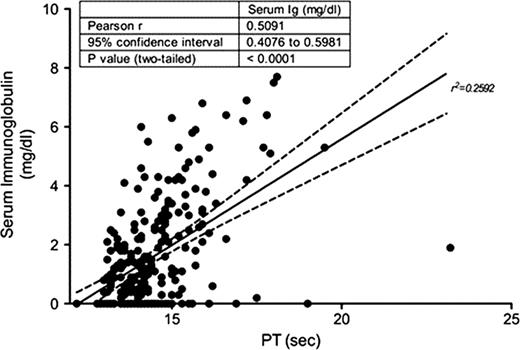Abstract
Secondary hemostatic defects resulting in bleeding diathesis occur in a subset of patients with plasma cell neoplasms due to a variety of mechanisms. Abnormal screening coagulation tests are frequently observed in asymptomatic patients with multiple myeloma and other plasma cell neoplasms. However, whether these coagulation abnormalities correlate with changes in serum proteins, diagnosis, or other disease parameters has not been systematically evaluated.
The objective of this study was to determine the prevalence of abnormal screening coagulation tests in patients with different plasma cell neoplasms and correlate clotting times with clinical history and diagnostic parameters.
The medical records of 292 consecutive patients referred to the Myeloma Institute for Research and Therapy at UAMS from January 2010 to October 2010 were reviewed. Nineteen patients were excluded because they lacked screening coagulation tests or did not fulfill WHO diagnostic criteria for plasma cell neoplasm. Prothrombin time (PT), activated partial thromboplastin time (APTT), and fibrinogen activity were determined using mechanical detection. Abnormal APTT was defined as clotting times outside the normal range (23–36.9 sec). Prolonged PT was defined as ≥15.0 seconds (normal range: 11.5–14.7 sec) or INR > 1.2. Patients with prolonged PT or APTT due to warfarin therapy, liver disease or disseminated intravascular coagulation were also excluded.
A total of 79 patients had abnormal screening coagulation tests. An isolated prolonged PT was found in 62 patients (25%) and 10 patients had prolonged PT and APTT (3.5%). An isolated prolonged APTT was present in 2 patients (<1%) and decreased APTT seen in 5 patients (2%). According to the clinical notes, none of the patients had significant bleeding.
Patients with isolated prolonged PT (62 total) and patients with normal screening tests (173 total) were compared with respect to age, fibrinogen, serum immunoglobulin level determined by protein electrophoresis, diagnosis, immunoglobulin isotype, and history of previous chemotherapy. There was no difference in age between patients with prolonged PT and those with normal PT (Table 1), previous chemotherapy or immunoglobulin isotype. Fibrinogen was significantly decreased in patients with prolonged PT (Table 1); however, there was no correlation between plasma fibrinogen and PT (p=0.1321). In contrast, serum immunoglobulin levels were significantly greater in patients with a prolonged PT (Table 1) and were positively correlated with PT (Figure 1).
Patient Characteristics
| . | All patients (mean ± SEM) . | PT < 15 sec (mean ± SEM) . | PT ≥ 15 sec (mean ± SEM) . | . |
|---|---|---|---|---|
| Age (yr) | 61.4 ± 0.718 | 60.9 ± 0.832 | 62.7 ± 1.415 | NS |
| Fibrinogen (mg/dL) | 414 ± 7.61 | 427 ± 8.43 | 377 ± 15.84 | p=0.0057 |
| Serum Immunoglobulin (g/dL) | 1.63 ± 0.119 | 1.11 ± 0.097 | 3.10 ± 0.287 | p<0.0001 |
| . | All patients (mean ± SEM) . | PT < 15 sec (mean ± SEM) . | PT ≥ 15 sec (mean ± SEM) . | . |
|---|---|---|---|---|
| Age (yr) | 61.4 ± 0.718 | 60.9 ± 0.832 | 62.7 ± 1.415 | NS |
| Fibrinogen (mg/dL) | 414 ± 7.61 | 427 ± 8.43 | 377 ± 15.84 | p=0.0057 |
| Serum Immunoglobulin (g/dL) | 1.63 ± 0.119 | 1.11 ± 0.097 | 3.10 ± 0.287 | p<0.0001 |
Values from patients with PT<15 sec were compared with those with PT≥15 sec using a Mann-Whitney (two-tailed) t-test.
Serum immunoglobulin levels and PT
As shown in Table 2, prolonged PT was more frequently observed in patients with multiple myeloma while patients with MGUS were less likely to have prolonged PT. No differences were observed with other plasma cell neoplasms; however, the numbers of patients in these diagnostic groups was small.
Patient Diagnosis
| Diagnosis . | All Patients . | PT <15 sec . | PT ≥ 15 sec . | OR . |
|---|---|---|---|---|
| Multiple Myeloma (MM) | 157 | 105 | 52 | 3.37 (p=0.0009) |
| MM, Non or Hyposecretory | 6 | 6 | 0 | NS |
| MM with Plasmacytoma | 4 | 4 | 0 | NS |
| Smoldering Myeloma | 21 | 16 | 5 | NS |
| MGUS | 34 | 30 | 4 | 0.33 (p=0.037) |
| Plasmacytoma | 11 | 10 | 1 | NS |
| Amyloid | 2 | 2 | 0 | NS |
| Total | 235 | 173 | 62 |
| Diagnosis . | All Patients . | PT <15 sec . | PT ≥ 15 sec . | OR . |
|---|---|---|---|---|
| Multiple Myeloma (MM) | 157 | 105 | 52 | 3.37 (p=0.0009) |
| MM, Non or Hyposecretory | 6 | 6 | 0 | NS |
| MM with Plasmacytoma | 4 | 4 | 0 | NS |
| Smoldering Myeloma | 21 | 16 | 5 | NS |
| MGUS | 34 | 30 | 4 | 0.33 (p=0.037) |
| Plasmacytoma | 11 | 10 | 1 | NS |
| Amyloid | 2 | 2 | 0 | NS |
| Total | 235 | 173 | 62 |
Incidence of elevated PT in patients with indicated disease was determined by Fisher's exact test. Odds-Ratio (OR) was calculated using GraphPad Prism.
An isolated prolonged PT (≥15 sec) was the most common abnormal coagulation test in our cohort. An association between disease severity and prolonged PT is suggested by our finding that patients with multiple myeloma were more likely to have prolonged PT than were patients with other plasma cell neoplasms. Of the factors examined, only serum immunoglobulin levels correlated with PT and were significantly elevated in patients with isolated prolonged PT.
No relevant conflicts of interest to declare.

This icon denotes a clinically relevant abstract
Author notes
Asterisk with author names denotes non-ASH members.


This feature is available to Subscribers Only
Sign In or Create an Account Close Modal